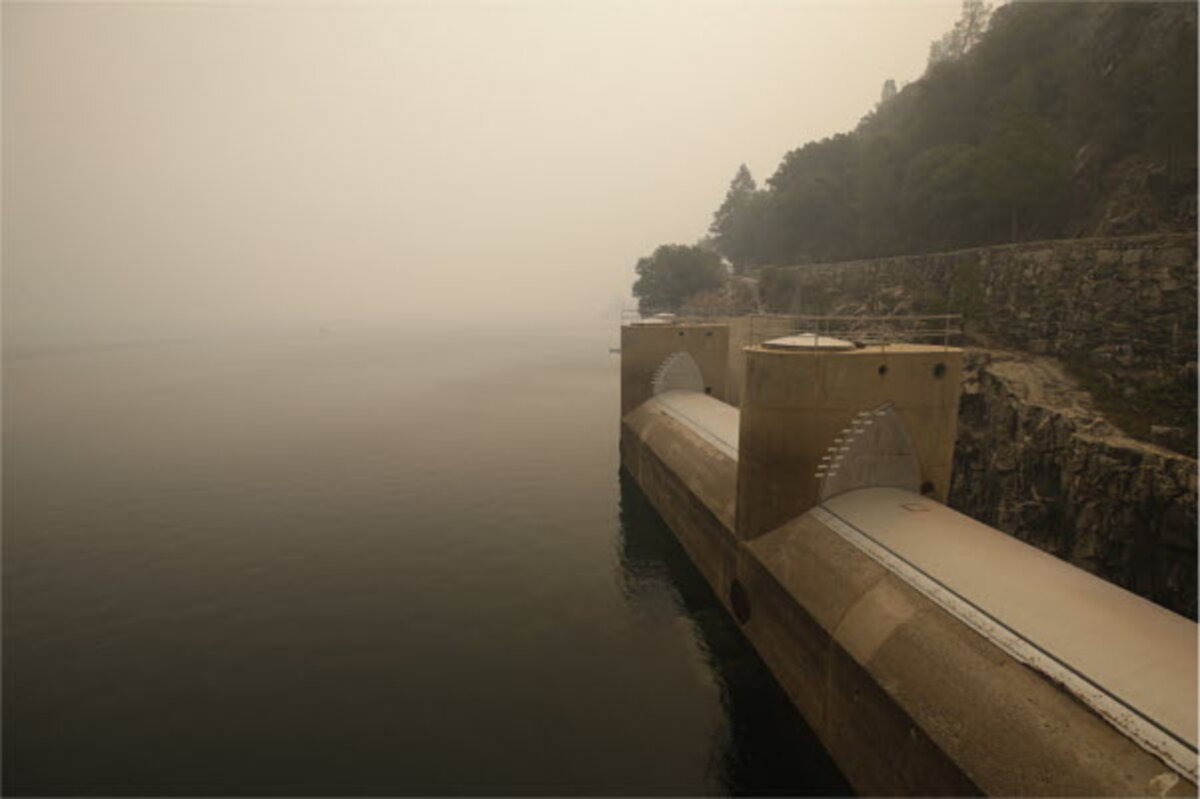Officials discount risk to drinking water from Rim Fire near Yosemite, so far
Loading...
| Los Angeles
The Rim Fire near Yosemite National Park in California – now 180,000 acres burned and 20 percent contained – continues to hold the full attention of water managers to the west in the San Francisco Bay Area, which relies on a reservoir near the fire for 85 percent of its drinking water. But authorities say there is no cause for alarm, at this early stage of the fire, about possible health effects from ash that the smoke is dropping onto Hetch Hetchy Reservoir.
The water being delivered 160 miles downstream to Bay Area residents remains safe, they say. One reason is that water drawn for customers is 270 feet below the reservoir surface. Another is that turbidity levels in the reservoir, being monitored by sensors 24 hours a day, are normal – exactly the same as before the fire started burning. Moreover, the entire network of storing and transporting water – from dams to concrete storage, to reservoirs and pipes – has seen a $4.6 billion upgrade over the past 10 years, just in time for a possible emergency such as this.
On top of that, contingency plans exist for delivering safe water to customers, should the level of pollutants rise in Hetch Hetchy. Those include filtering the water from the reservoir, if need be, or simply using water from other unthreatened reservoirs.
“We are continuing to monitor the water 24/7, so if there is any danger at all we will know immediately and switch to alternative sources,” says Alison Kastama, spokeswoman for the San Francisco Public Utilities Commission (SFPUC). The two reservoirs that store the Bay Area’s remaining 15 percent of supply are right in the Bay Area, in Alameda and San Mateo – far from the Rim Fire. “We are shifting ample supplies to these other reservoirs just in case,” she says.
What about concern that the real threat will come in the spring, when runoff from rain and melting snow up in the Sierra Nevada will carry residual ash on the ground into the water supply? Ms. Kastama and others take issue with that assessment.
“One of the things that strikes me about the whole situation is that none of the lands that are actually watersheds that run into Hetch Hetchy have burned so far,” says Jan van Wagtendonk, research forester emeritus for the US Geological Survey’s Yosemite Field Station. Most of the watershed above the reservoir is granite, with very few trees, he says, and the Rim Fire is unlikely to get to the forested areas beyond.
“People tend to be alarmist, especially water people,” says Dr. van Wagtendonk. “It’s likely that in other areas you will get some runoff after a spring storm, but nothing to create alarm.”
Water from Hetch Hetchy has a reputation as for being pure and clear. Indeed, California has granted Hetch Hetchy water a waiver from having to be filtered because of measures that nearby cities and towns have taken over the years to ensure that the water will stay pristine. Regional governments have hired rangers and other personnel to patrol the area around the reservoir to tell people how to properly dispose of waste, he says. “A lot of money has been spent keeping this water pristine,” he says.
Not everyone is sanguine, however, about the possible threats from the Rim Fire to drinking water. Firefighting expert Char Miller, a professor of environmental analysis at Pomona College in Claremont, Calif., says Colorado’s Hayman Fire in 2002, which was the largest in the state at that time, may offer California water managers some lessons. He says water providers from the cities of Denver and Aurora spent $25 million over two years to remove sediment that, after the fire, washed into a reservoir that serves as a source of drinking water.
“The Denver Water Board went through a similar issue after the devastating 2002 Hayman Fire,” says Mr. Miller. “I’m not sure what the water managers [in San Francisco] are doing excepting praying that that fire – and especially the ash and, later this winter, rain-pushed debris flow – don’t gum up the works, quite literally.”
If van Wagtendonk is correct, that is not likely to happen with the Rim Fire.
“There has been some misinformation, despite our best efforts,” says Charlie Sheehan, spokesman for SFPUC. “But we are literally monitoring the situation around the clock all the way from Yosemite to San Francisco. And there is no change [to water quality] as of yet.”
The commission is taking extra steps to reassure the public.
“Thanks to our $4.6 billion Water System Improvement Program (WSIP), we have critical water interties with East Bay Municipal Utilities District (EBMUD) and Santa Clara Valley Water District (SCVWD) to deliver water between water systems during emergencies,” says a fact sheet at the website of San Francisco Water and Power, a part of SFPUC.




